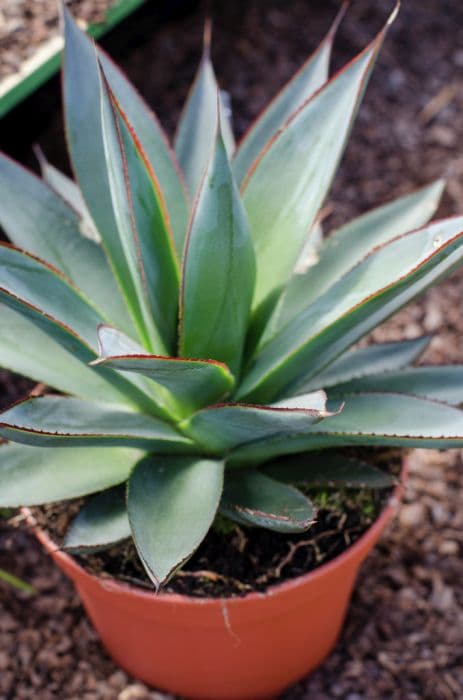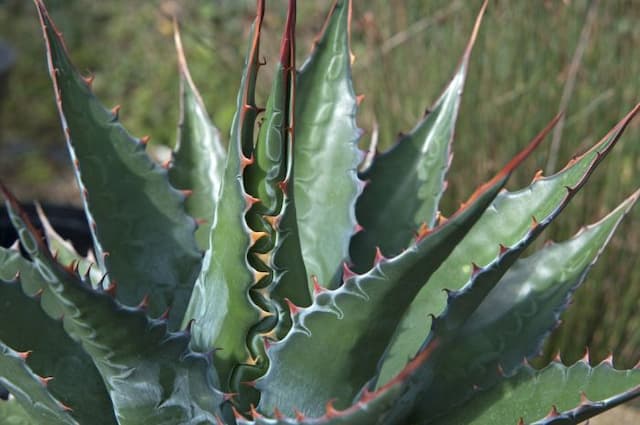Starlight Spider Plant Chlorophytum saundersiae 'Starlight' (PBR) (v)

ABOUT
The Chlorophytum saundersiae 'Starlight' (PBR) (v), commonly known as the Starlight Spider Plant, showcases a striking appearance that draws attention in any space. This plant features a rosette of narrow, arching leaves that boast a fresh, vibrant green color. Each leaf is beautifully variegated with white margins and stripes that run along the length, creating a pattern that resembles a starlit sky. The leaves are typically long, slender, and come to a delicate point, giving the plant an elegant and slightly wild aspect. As it matures, the Starlight Spider Plant may produce small, star-shaped flowers that dangle daintily from the center of the rosette on long, wiry stems known as inflorescences. These flowers are often a soft white or pale lavender shade, adding a subtle touch of color to the overall green and white palette. In addition, the Starlight Spider Plant is known for its ability to produce 'pups' or small plantlets that emerge on similar long stems, creating the effect of a miniature constellation surrounding the mother plant. These plantlets can eventually form their own roots and be separated to propagate new plants. The combination of the striking leaf variegation, the delicate flowers, and the charming plantlets make the Starlight Spider Plant a truly appealing and ornamental houseplant.
About this plant
 Names
NamesFamily
Asparagaceae
Synonyms
Starlight Chlorophytum, Starlight Spider Plant, Variegated Starlight.
Common names
Chlorophytum saundersiae 'Starlight' (PBR) (v).
 Toxicity
ToxicityTo humans
Chlorophytum saundersiae 'Starlight', commonly known as the Starlight plant, is not toxic to humans. It is generally considered safe and there are no known toxic effects from ingesting this plant.
To pets
The Starlight plant is also non-toxic to pets. It is not known to cause any harmful effects if animals ingest it, making it a pet-friendly plant option for households.
 Characteristics
CharacteristicsLife cycle
Perennials
Foliage type
Evergreen
Color of leaves
Variegated
Flower color
White
Height
1 foot (30 cm)
Spread
1 foot (30 cm)
Plant type
Herb
Hardiness zones
9
Native area
South Africa
Benefits
 General Benefits
General Benefits- Easy to Care: Chlorophytum saundersiae 'Starlight' is low maintenance and can survive with minimal care, making it suitable for busy people or those new to gardening.
- Drought Tolerant: It is relatively drought-resistant, requiring infrequent watering and thus conserving water resources.
- Aesthetic Appeal: This plant adds visual interest to any setting with its variegated foliage and graceful flow, enhancing the beauty of indoor and outdoor spaces.
- Growth Habit: With its clumping growth pattern, it can fill spaces effectively in garden beds or containers, providing lush greenery.
- Non-Toxic: The plant is safe around pets and children as it is not known to be toxic when ingested, reducing the risk of poisoning accidents.
- Adaptability: It is adaptable to a range of lighting conditions from partial shade to bright indirect light, making it suitable for various locations in a home or office.
- Decorative Planters: Its striking appearance complements decorative planters and can be used as a stylish accent in home decor.
- Fast Growing: Chlorophytum saundersiae 'Starlight' grows fairly quickly, allowing for a faster realization of its full aesthetic potential in a garden or pot.
 Medical Properties
Medical PropertiesThis plant is not used for medical purposes.
 Air-purifying Qualities
Air-purifying QualitiesThis plant is not specifically known for air purifying qualities.
 Other Uses
Other Uses- Photography prop: The attractive variegated leaves of the Starlight plant can be used as a background or accent in macro photography to add natural texture and interest.
- Educational tool: Children can learn about plant growth and care by observing the fast-growing spiderettes of the Starlight plant.
- Craft materials: The leaves of the Starlight plant can be used in craft projects, such as leaf-printing or for creating greenery in miniature landscapes.
- Biodegradable decorations: Live or dried Starlight plants can be used as eco-friendly party or wedding decorations that can be composted after use.
- Water conservation: Incorporating Starlight plants in xeriscaped gardens as they can tolerate periods of neglect, thus conserving water.
- Theme gardens: Use them to create a 'starlight' or celestial theme in a garden, playing off their name and the shape of their flowers.
- Stress relief: Caring for the Starlight plant, with its minimal needs, can be a stress-relieving hobby for those looking to connect with nature.
- Living gifts: They can serve as sustainable, living gifts that grow and can be shared, as they produce many offsets (spiderettes).
- Pet entertainment: Some cats enjoy lightly batting at the dangling spiderettes without the concern of toxicity since the plant is non-toxic to pets.
- Bath additive: Leaves can be added to bathwater for a natural, light fragrance and to add a touch of luxury to bathing routines.
Interesting Facts
 Feng Shui
Feng ShuiThe Spider Plant is used in Feng Shui to promote positive energy and purify the air. It is often placed in areas where people want to encourage growth and vitality, such as the family area (east) or health area (east-central) of a space. Its upward growing foliage is believed to uplift the chi (energy) in a home or office.
 Zodiac Sign Compitability
Zodiac Sign CompitabilityThe Spider Plant is not used in astrology practice.
 Plant Symbolism
Plant Symbolism- Purity: The bright white patterns on its leaves are often associated with cleanliness and purity.
- Innocence: It's delicate and unblemished appearance could symbolize a sense of innocence or simplicity.
- Growth & Vitality: As a houseplant that grows and regenerates easily, it can represent personal growth or renewed vitality.
- Protection: Known for being an air-purifying plant, it symbolizes protection against negative influences or toxins in one's environment.
- Good Fortune: In some cultures, gifting this plant may be considered a wish for good luck and prosperity.
 Water
WaterThe Starlight Spider Plant needs to be watered approximately once a week, but the frequency may vary depending on the environment. It prefers to dry out slightly between waterings, so ensure the top inch of the soil is dry before watering again. Provide enough water to moisten the soil thoroughly each time, which usually equates to about 16 ounces for a medium pot. Reduce watering frequency during the winter months when the plant's growth slows down.
 Light
LightThe Starlight Spider Plant thrives in bright, indirect sunlight. It's best positioned in a spot where it can receive plenty of light without being exposed to the harsh midday sun. A north-facing window or a location that receives filtered light through a sheer curtain is ideal.
 Temperature
TemperatureThe Starlight Spider Plant prefers temperatures between 65-75 degrees Fahrenheit but can tolerate a range down to 50 degrees Fahrenheit and up to 90 degrees Fahrenheit. However, the ideal conditions lie within the moderate range, avoiding any extreme cold or heat.
 Pruning
PruningPrune the Starlight Spider Plant to remove dead or yellowing leaves and to encourage bushier growth. The best time to prune is in the spring or early summer. Occasional removal of older leaves allows the plant to put more energy into new growth. Do not prune too frequently; once or twice a year is sufficient.
 Cleaning
CleaningAs needed
 Soil
SoilThe Spider Plant 'Starlight’ thrives in a well-draining potting mix with a pH of 6.0 to 7.2. A mix of one part peat, one part perlite, and one part compost is recommended to retain moisture while preventing waterlogging. Regular potting soil amended with perlite or coarse sand would also suit its needs.
 Repotting
RepottingSpider Plants 'Starlight’ should be repotted every 2-3 years or when they become root-bound. Choose a pot that is slightly larger than the current one to give the roots room to grow. The best time for repotting is in the spring or early summer.
 Humidity & Misting
Humidity & MistingSpider Plants 'Starlight’ prefer a humidity level of around 40-50%. They are quite adaptable but may benefit from occasional misting or a pebble tray to boost the humidity if the indoor air is very dry.
 Suitable locations
Suitable locationsIndoor
Place in bright, indirect light and water moderately.
Outdoor
Partial shade, shelter from strong winds, moist soil.
Hardiness zone
9-11 USDA
 Life cycle
Life cycleChlorophytum saundersiae 'Starlight', commonly known as the Starlight Spider Plant, begins its life cycle when a seed germinates in warm, moist soil, growing into a small seedling. With adequate light and water, the seedling develops into a rosette of arching, variegated leaves, establishing a strong root system. As the plant matures, it produces small white flowers on slender stalks that can lead to the formation of seeds, continuing the cycle. Additionally, the Starlight Spider Plant is known for its ability to produce plantlets, or "pups", on these flowering stems, which can root themselves when in contact with soil, effectively cloning the parent plant. Pups can be detached and planted independently to propagate new plants. Throughout its life, the Starlight Spider Plant requires moderate care with consistent moisture and indirect light, and it can live for several years under the right conditions.
 Propogation
PropogationPropogation time
Spring-Summer
The Chlorophytum saundersiae 'Starlight', commonly known as the Starlight Spider Plant, is typically propagated through division, a simple and highly effective method. This process involves gently separating the small plantlets, which develop on long runners originating from the main plant, when they have a few roots of their own. These plantlets are often already starting to form their own root systems. To propagate via division, one must wait until the offshoot has developed a decent amount of roots, generally an inch or two (2.5 to 5 cm), and then cut the runner. The young plant can then be potted up in well-draining potting mix, ensuring that the roots are spread out and covered with soil. Water the new plant thoroughly and keep it in a location with indirect light. In a few weeks, it will establish a stronger root system and begin to grow as an independent plant.









